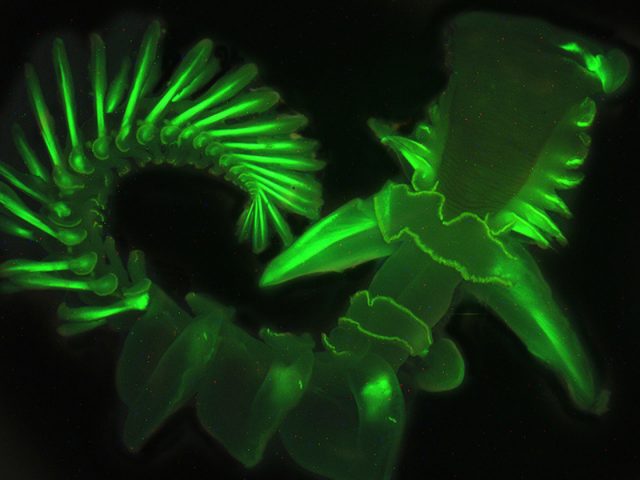MI weekly selection #49

Credit: Dimitri Deheyn, Scripps Institution of Oceanography, UC San Diego
Researchers try to figure out sea worm’s blue glow
Researchers are a step closer to figuring out why a common sea worm glows blue on the shallow seafloors it calls home, thanks to a pair of experiments conducted by biologists at Scripps Institution of Oceanography. First, they found that the worm, unlike other light-emitting organisms, doesn’t need oxygen, which reacts with other chemicals to produce light. Separately, they found that riboflavin has a key role in the worm’s light production, but they’ve yet to determine what that role is.
Nickel, iron present in jets emitted from black holes
The powerful jets emitted by a black hole contain evidence of nickel and iron. “Until now, it wasn’t clear whether the positive charge came from positrons, the antimatter ‘opposite’ of electrons, or positively charged atoms. Since our results found nickel and iron in these jets, we now know ordinary matter must be providing the positive charge,” said James Miller-Jones of the International Center for Radio Astronomy Research and co-author of the study.
What can we learn from the Depression?
Since the start of what some now call the “Great Recession” in 2007, economists have been unable to avoid comparing it with the Depression of the early 1930s. For some, the comparisons are explicit. Economists like Paul Krugman and Barry Eichengreen have drawn parallels between the two slumps. Olivier Blanchard, chief economist of the International Monetary Fund (IMF), warned several times over the last few years that the world risked falling into a new “Great Depression”. Economic historians themselves have had an unprecedented role in policy making during the recent crisis.
Sun producing fewer sunspots
The sun is producing about half the sunspots it normally does and the drop in these solar occurrences, which often damage electrical systems or foul satellites, is puzzling. “There is no scientist alive who has seen a solar cycle as weak as this one,” said Andrés Munoz-Jaramillo, with the Harvard-Smithsonian Center for Astrophysics.
Microwaves captured to transmit power
A Duke University team has succeeded in transmitting power via microwaves with an efficiency comparable to solar cells. The team used fiberglass and copper conductors on a circuit board to produce 7.3 volts of electricity. “We had been getting energy efficiency around 6 to 10%, but with this design, we were able to dramatically improve energy conversion to 37%,” said Allen Hawkes, a member of the team.